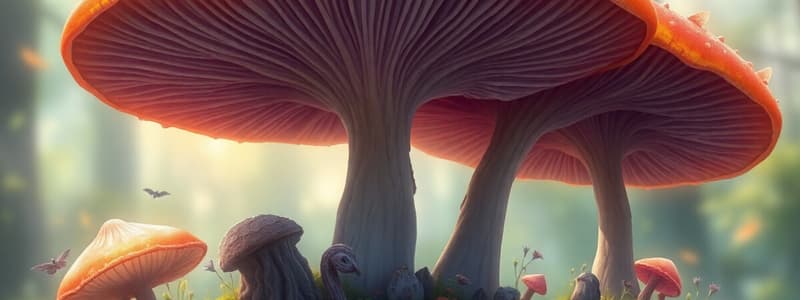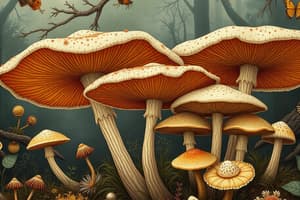Podcast
Questions and Answers
What type of organism are fungi classified as?
What type of organism are fungi classified as?
- Prokaryotic autotrophs
- Eukaryotic heterotrophs (correct)
- Eukaryotic autotrophs
- Prokaryotic heterotrophs
Which of the following correctly describes the cell walls of fungi?
Which of the following correctly describes the cell walls of fungi?
- Made of cellulose
- Made of chitin (correct)
- Made of keratin
- Made of protein
What are the tiny filament structures found in multicellular fungi called?
What are the tiny filament structures found in multicellular fungi called?
- Mycelium
- Fruiting bodies
- Hyphae (correct)
- Sporangia
What is the primary method of reproduction for molds in the phylum Zygomycota?
What is the primary method of reproduction for molds in the phylum Zygomycota?
Which of the following fungi can cause a condition known as thrush?
Which of the following fungi can cause a condition known as thrush?
Which phylum do puffballs belong to?
Which phylum do puffballs belong to?
What characteristic distinguishes club fungi?
What characteristic distinguishes club fungi?
Which statement correctly describes the majority of fungi in terms of their ecological role?
Which statement correctly describes the majority of fungi in terms of their ecological role?
What type of cells do fungi have?
What type of cells do fungi have?
What substances are commonly found in the cell walls of fungi?
What substances are commonly found in the cell walls of fungi?
Which phylum do molds that grow on foods like cheese and bread belong to?
Which phylum do molds that grow on foods like cheese and bread belong to?
What kind of nutrition do fungi primarily exhibit?
What kind of nutrition do fungi primarily exhibit?
What is a characteristic feature of sac fungi?
What is a characteristic feature of sac fungi?
Which of the following fungi is known to be a decomposer?
Which of the following fungi is known to be a decomposer?
Which type of fungal structure is primarily visible when observing mushrooms?
Which type of fungal structure is primarily visible when observing mushrooms?
What is the method of reproduction commonly utilized by fungi?
What is the method of reproduction commonly utilized by fungi?
Which term describes fungi that can cause diseases in humans?
Which term describes fungi that can cause diseases in humans?
Which statement about club fungi is true?
Which statement about club fungi is true?
What unique characteristic do the cell walls of fungi possess?
What unique characteristic do the cell walls of fungi possess?
Which of the following describes the majority of fungi?
Which of the following describes the majority of fungi?
Which phylum does the organism known as Candida, which can cause thrush, belong to?
Which phylum does the organism known as Candida, which can cause thrush, belong to?
What type of fungi is known for forming fruiting bodies?
What type of fungi is known for forming fruiting bodies?
Which of the following statements is true regarding yeast?
Which of the following statements is true regarding yeast?
Flashcards are hidden until you start studying
Study Notes
Kingdom Fungi
- Includes yeasts, molds, and mushrooms
- Except for yeasts, all fungi are multicellular
- Fungi are eukaryotic heterotrophs
- Have cell walls containing chitin
- Fungi are heterotrophs (cannot make their own food)
- Most are decomposers, absorbing nutrients from dead or decaying matter
Reproduction
- Fungi reproduce both sexually and asexually (through spores)
Multicellular Fungi
- Have tiny filament structures called hyphae
- Also have reproductive structures called fruiting bodies
- Mushrooms are an example of fruiting bodies
- Most of a fungus is underground, with filaments extending for meters
Unicellular Fungi (Yeasts)
- Some are used for baking and brewing
- Some can cause disease in humans
Athlete's Foot
- Caused by a fungal parasite called deuteromycetes
Thrush
- A mouth infection caused by Candida
Common Molds
- Grow on foods like meat, cheese, and bread
- Belong to the phylum Zygomycota
- Reproduce or spread through spores
Sac Fungi
- Belong to the phylum Ascomycota
- Have a reproductive structure that contains spores
- Include puff balls
Club Fungi
- Belong to the phylum Basidiomycota
- Called club fungi due to their reproductive structures
- Examples include mushrooms
- Some are edible, others are poisonous
- Some produce deadly toxins
Kingdom Fungi
- Includes yeasts, molds, and mushrooms
- Most fungi are multicellular
- Fungi are eukaryotic heterotrophs whose cell walls contain chitin
- Chitin is a complex carbohydrate found in insect shells
- Most fungi are decomposers meaning they absorb nutrients from dead or decaying organic matter
- Fungi reproduce both sexually and asexually
- Asexual reproduction occurs through the use of spores
- Multicellular fungi have tiny filament structures called hyphae
- Multicellular fungi also have reproductive structures called fruiting bodies
- Mushrooms are an example of a fruiting body
- When you see a mushroom on the ground you are only seeing a small portion of the whole organism
- The filaments may extend for several meters
- Fungi include some of the largest organisms on Earth
Unicellular Fungi (Yeasts)
- Some yeasts are used for baking and brewing
- Some yeasts can cause disease in humans
- Athlete's foot is caused by a fungal parasite called deuteromycetes which can cause infection between the toes
- Candida can cause infections in the mouth called thrush
Common Molds
- Molds that grow on foods like meat, cheese, and bread belong to the phylum Zygomycota
- Molds reproduce or spread through the use of spores
Sac Fungi
- Included in the phylum Ascomycota
- Sac fungi have a reproductive structure which contains spores
- Puff balls fall into this category
Club Fungi
- In the phylum Basidiomycota
- Called club fungi because of the reproductive structures that they form
- Examples would be mushrooms
- Some mushrooms are edible whereas others can be extremely poisonous
- Some fungi produce deadly toxins
Kingdom Fungi
- Includes yeasts, molds, and mushrooms
- All fungi (except yeasts) are multicellular
- They are eukaryotic heterotrophs
- They have cell walls made of chitin
- Most are decomposers
- Fungi absorb nutrients from dead or decaying organic matter
- They reproduce sexually and asexually (using spores)
- Multicellular fungi have tiny filament structures called hyphae
- Fruiting bodies are reproductive structures that grow above ground, and mushrooms are a common example
- Fruiting bodies represent a small portion of the whole fungal organism
- The filaments can grow for several meters
Unicellular Fungi (Yeasts)
- Used in baking and brewing
- Can cause disease in humans
- Athlete's foot is caused by a fungal parasite called deuteromycetes
- Candida can cause oral thrush
Common Molds
- Grow on foods like meat, cheese, and bread
- Belongs to the phylum Zygomycota
- Reproduce and spread using spores
Sac Fungi
- Included in the phylum Ascomycota
- Have a reproductive structure that contains spores
- Puffballs fall into this category
Club Fungi
- Belongs to the phylum Basidiomycota
- Called club fungi due to their reproductive structures
- Mushrooms are a common example
- Some mushrooms are edible, while others can be poisonous
- Some fungi produce deadly toxins
Studying That Suits You
Use AI to generate personalized quizzes and flashcards to suit your learning preferences.




